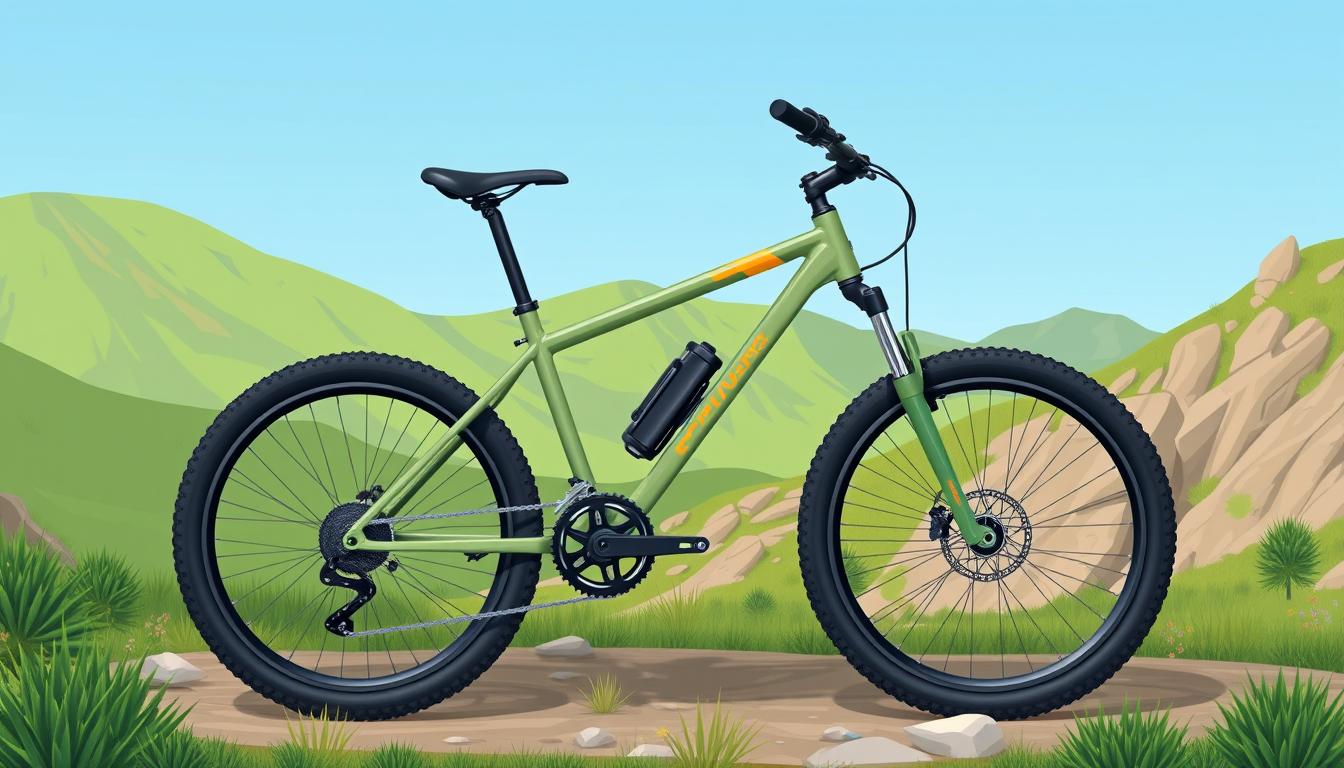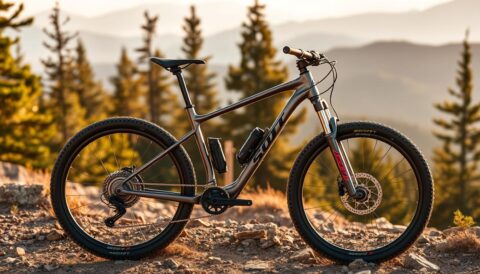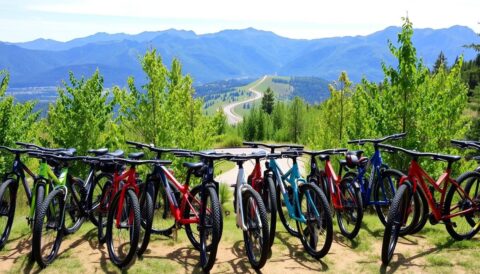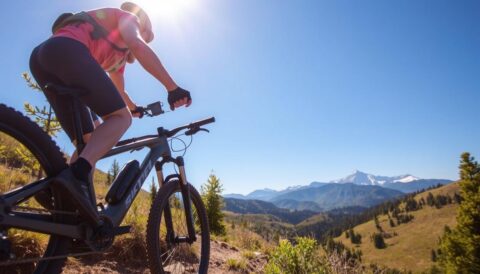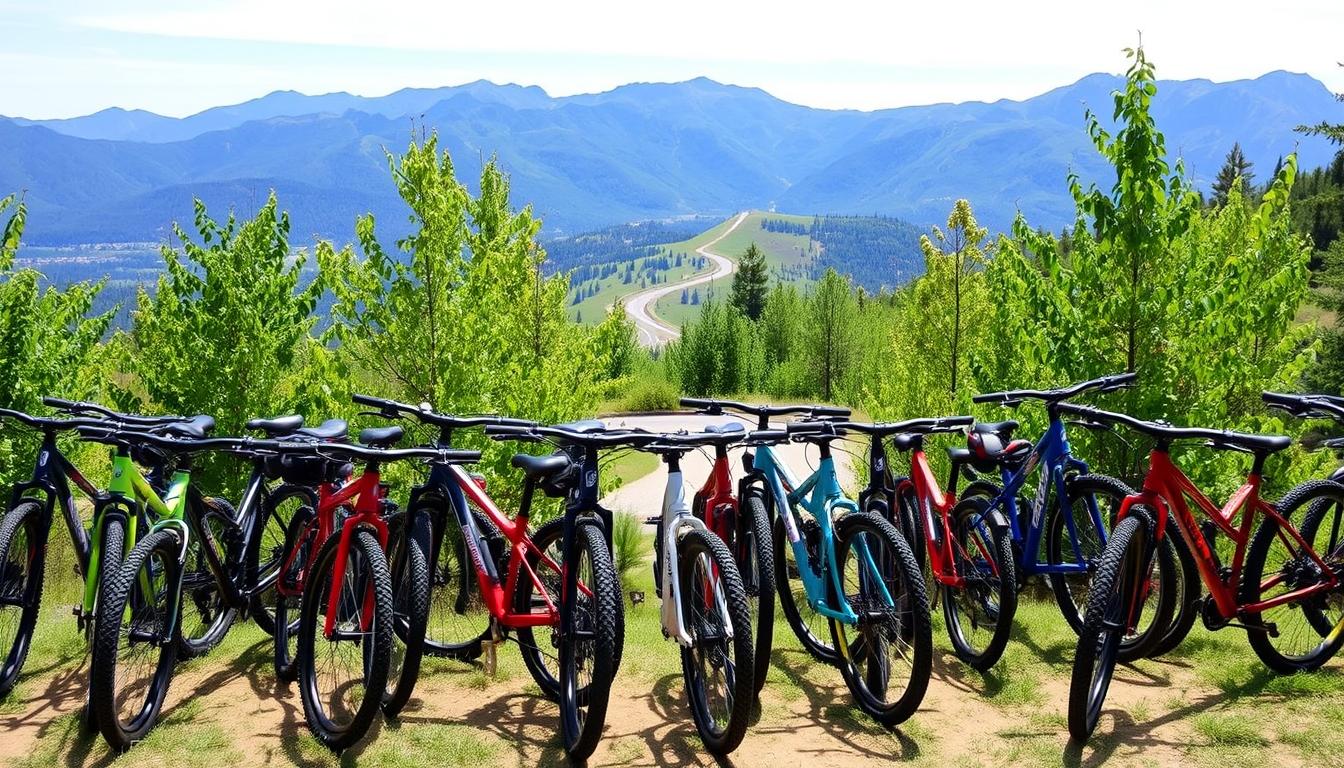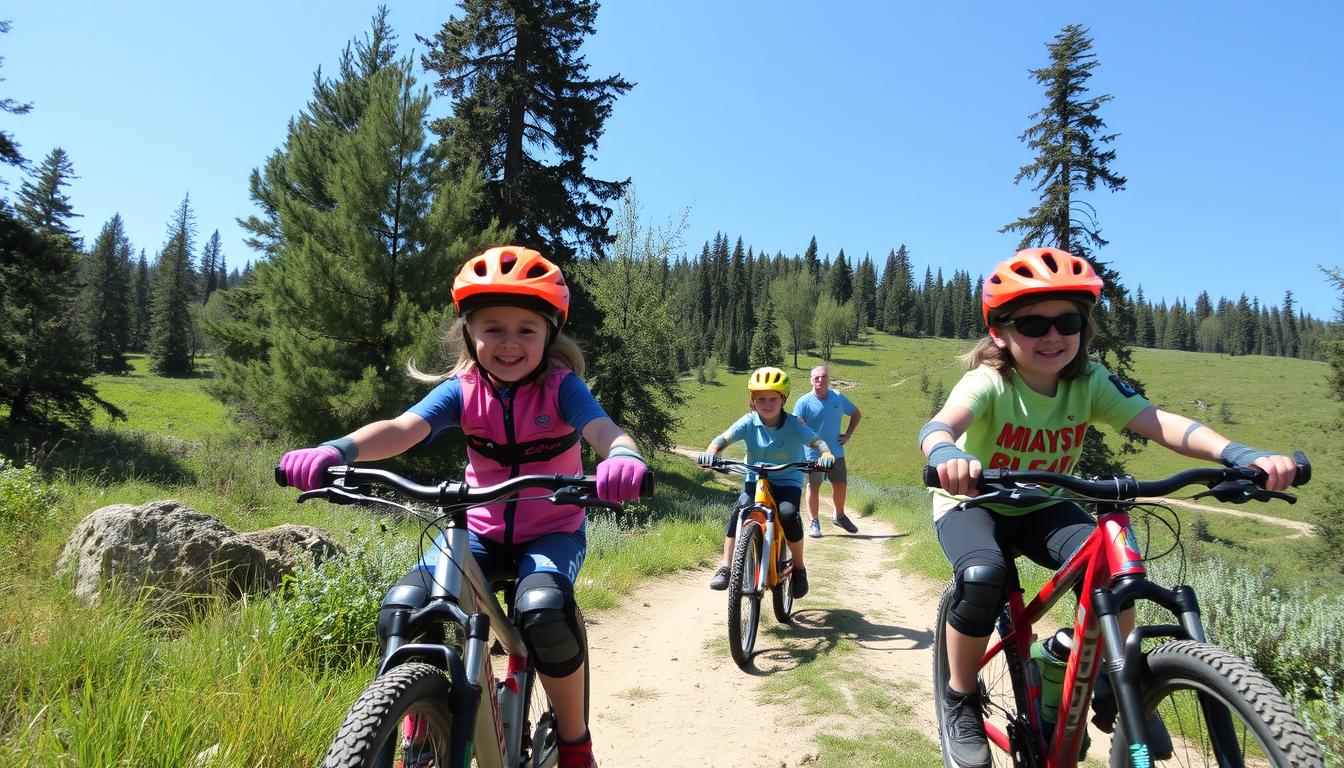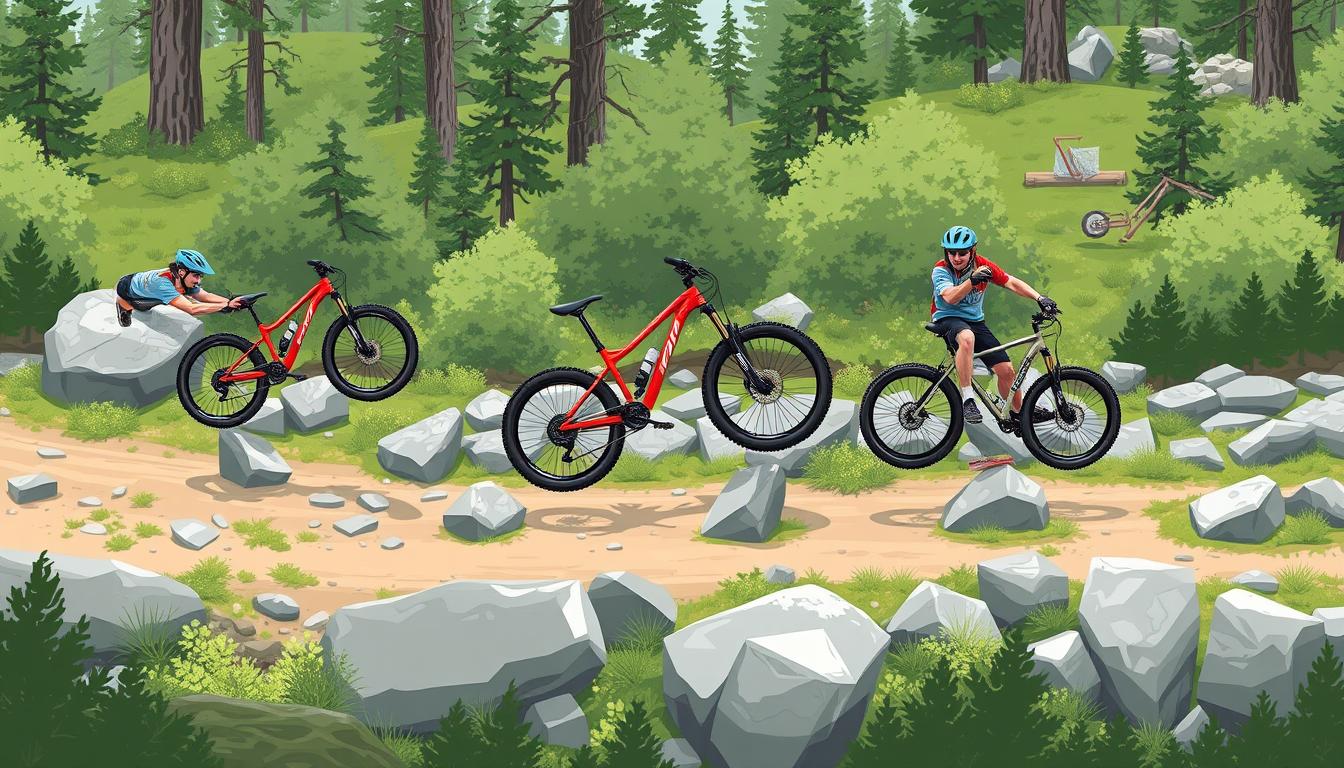Mountain biking has evolved since the 1980s, offering thrilling experiences for riders of all levels. The first mass-produced mountain bikes marked a significant milestone in cycling technology1. For newcomers, picking the right bicycle can be both exciting and daunting.
Modern mountain bikes come in various styles for different terrains and riding experiences. Selecting the ideal mountain bike involves understanding your preferences and comfort level. New riders should prioritise bikes that boost confidence and enjoyment.
The market offers options from lightweight cross-country models to sturdy trail bikes. Most frames are made of aluminium alloy or carbon fibre, giving beginners reliable choices1. Grasping bike geometry, wheel sizes, and frame materials helps make an informed decision.
Mountain bike manufacturers provide sizes from XS for shorter riders to XXL for taller cyclists1. This ensures everyone can find their perfect fit. Your choice can transform your cycling journey, whether you prefer gentle trails or adventurous off-road rides.
Understanding Mountain Bike Types and Categories
Mountain biking offers various bike types for different terrains and riding styles. The world of mountain bike types can be confusing. Yet, grasping the key categories helps riders pick the perfect ride2.
Mountain bikes fall into several distinct categories. Each category has unique features suited to specific riding experiences2.
- Cross-Country (XC) Bikes
- Trail Bikes
- Enduro Bikes
- Downhill Bikes
Cross-Country (XC) Bikes for Efficiency
XC bikes are the lightweight stars of mountain biking. They’re built for speed and climbing efficiency3. These bikes usually have 80-120mm suspension travel.
XC bikes suit riders who love quick climbs and long rides4. Popular models like the Specialized Epic and Trek Supercaliber offer top performance for competitive cyclists2.
Trail Bikes for Versatility
Trail bikes are the most popular mountain bike type. They balance climbing and descending abilities well2. With 120-150mm suspension travel, trail bikes like the Specialized Stumpjumper handle mixed terrains brilliantly3.
All-Mountain and Enduro Bikes for Technical Terrain
Enduro bikes are made for daring riders who enjoy tough descents. These sturdy machines boast 150-180mm suspension travel. This allows confident riding through rugged landscapes2.
Models like the Specialized Enduro tackle demanding downhill sections with ease. They also maintain decent climbing abilities2.
Choosing the right mountain bike depends on your riding style, preferred terrain, and personal preferences.
How to Choose a Mountain Bike for Beginners: Essential Factors
Choosing the right mountain bike involves several key factors. Beginners must evaluate their needs and riding goals. This assessment helps make an informed decision5.
- Riding Style: Determine your primary cycling goals and terrain preferences
- Skill Level: Match the bike to your current abilities
- Budget: Establish a realistic spending range
Budget is crucial in mountain bike selection. Entry-level bikes typically cost between $1,000 and $2,500 AUD. This price range offers quality hardtails or basic dual suspension options6.
Beginners should aim for a bike that balances quality and affordability. This approach ensures a good starting point for your mountain biking journey.
| Rider Level | Recommended Bike Type | Key Characteristics |
|---|---|---|
| Beginner | Hardtail XC Bike | Lightweight, Simple, Affordable |
| Intermediate | Trail Bike | Versatile, Balanced Performance |
| Advanced | Enduro Bike | Technical Terrain, Aggressive Riding |
Wheel size is another vital factor for beginners. Most bikes have 27.5-inch or 29-inch wheels. Larger 29-inch wheels help riders tackle obstacles more easily5.
These bigger wheels provide added confidence on varied terrain. This feature can be particularly beneficial for those new to mountain biking.
Choosing the right mountain bike is about finding the perfect balance between your skills, ambitions, and comfort.
Consider your local trails and fitness level when selecting a bike. A suitable bike will match your current abilities. This choice will help you progress safely and enjoy mountain biking7.
Mountain Bike Frame Materials and Construction
Your riding experience hinges on selecting the right mountain bike frame. Mountain bike frame materials greatly influence performance, durability, and overall feel8.
Four main frame materials are used in mountain bikes. Each material has its own unique traits.
- Aluminium alloy
- Carbon fibre
- Steel
- Titanium
Aluminium Alloy: The Popular Choice
Aluminium remains the most common frame material. About 70-80% of mountain bikes use aluminium frames8. Its popularity stems from affordable production costs and versatility.
Carbon Fibre: Lightweight Performance
Carbon fibre has transformed mountain bike design since 1998. Pro racers now use carbon fibre bikes exclusively in major tours8. It offers superior strength-to-weight ratio, perfect for competitive riders.
Alternative Frame Materials
Steel and titanium are less common but still valuable options. Steel frames offer excellent durability and a smooth ride8. They’re typically heavier than other materials.
| Frame Material | Weight | Cost | Durability |
|---|---|---|---|
| Aluminium | Light | Low | Good |
| Carbon Fibre | Very Light | High | Excellent |
| Steel | Heavy | Low | Very Good |
| Titanium | Light | Very High | Exceptional |
The right frame material can transform your mountain biking experience, balancing performance, comfort, and budget.
Wheel Size Options and Their Impact
Mountain bike wheel sizes greatly affect your riding experience. The main options are 26-inch, 27.5-inch, and 29-inch wheels. Each size offers unique traits for different riding styles910.

Wheel size nuances can boost your cycling performance. 29-inch wheels have become quite popular recently. They excel in downhill and enduro bikes, offering great stability and speed9.
- 29-inch wheels provide a larger contact patch, enhancing ground grip9
- 27.5-inch wheels offer a balanced compromise between agility and stability9
- Mullet bike configurations combine a 29-inch front wheel with a 27.5-inch rear wheel for optimal performance10
Your wheel size choice depends on your riding terrain and preferences. 29-inch wheels offer less rolling resistance and more stability. They’re great for beginners on tricky trails10.
| Wheel Size | Characteristics | Best Suited For |
|---|---|---|
| 26-inch | Traditional, more responsive | Technical manoeuvring |
| 27.5-inch | Balanced performance | Trail and all-mountain riding |
| 29-inch | Stable, higher momentum | Downhill and enduro riding |
Pro tip: Think about your riding style, terrain, and comfort when picking wheel sizes. Each option can boost your mountain biking fun11.
Remember, the right wheel size can transform your riding performance and enjoyment!
Budget Considerations and Price Ranges
Your budget affects your mountain bike’s quality and performance. Affordable mountain bikes come in various price ranges. These ranges suit different skill levels and expectations12.
Entry-Level Mountain Bikes
New riders can find entry-level bikes from £800 to £2,000. These bikes are great for beginners exploring mountain biking13. They offer reliable aluminium frames and basic components.
These bikes perform well on moderate trails12.
- Aluminium frame construction
- Basic suspension systems
- Hydraulic disc brakes
- Standard 1×10 or 1×11 gearing
Mid-Range Mountain Bike Selections
Bikes between £2,000 and £4,000 offer better performance and quality. Riders get more sophisticated components and improved experiences13. These bikes often feature wireless drivetrains and lighter materials.
Premium Mountain Bike Options
Premium bikes cost £4,000 and above. They boast exceptional engineering and specialised builds. These bikes use cutting-edge tech, carbon fibre frames, and top-tier components13.
“Invest in a mountain bike that matches your skills and ambitions, balancing budget with performance potential.”
Choose a bike that fits your riding style and terrain. Consider your long-term cycling goals too. This approach helps you make the best decision12.
Conclusion
Choosing your first mountain bike requires careful thought. Consider your riding style, budget, and preferred terrain. Beginners should opt for entry-level bikes that build a solid foundation.
Most new riders start with affordable options. These bikes have basic components that help boost confidence and technique14.
The ideal beginner’s bike balances comfort, performance, and cost. Entry-level mountain bikes typically cost between £300 and £1,000. These offer essential features for new riders14.
Trek, Specialized, and Giant offer excellent starter options. Their bikes cater to various skill levels14.
Focus on enjoying your ride rather than technical details. Consider frame material, wheel size, and suspension type that suit your environment. Regular upkeep every 3-6 months can boost your bike’s lifespan14.
With thorough research, you’ll find a bike that enhances your outdoor adventures. Test different models and seek advice from experienced riders. Trust your gut when making this exciting purchase.
Your chosen bike should inspire trail exploration and self-challenge. It should help you embrace the thrilling world of mountain biking.
FAQ
What type of mountain bike is best for a complete beginner?
Trail bikes offer the best versatility for most beginners. They provide a balanced riding experience on various terrains. These bikes are comfortable, forgiving, and excel on smooth paths and moderately challenging trails.
How much should I expect to spend on my first mountain bike?
Budget between £800 and £2,000 for a quality entry-level mountain bike. This range offers reliable components and decent frame materials. Avoid extremely cheap bikes, as they may compromise on durability and comfort.
What wheel size is recommended for beginners?
29-inch wheels are typically the best choice for beginners. They offer excellent stability and roll over obstacles more easily. This wheel size is forgiving for new riders and works well on most terrains.
Should I choose an aluminium or carbon fibre frame?
For beginners, an aluminium frame is usually the most practical choice. It offers a great balance between affordability, durability, and performance. Carbon fibre frames are lighter but significantly more expensive and less forgiving.
What’s the difference between cross-country and trail bikes?
Cross-country bikes are designed for speed on smoother terrain. Trail bikes are more versatile and perform better on mixed terrain. They have slightly more suspension and a more relaxed geometry for recreational riders.
How do I know what size mountain bike I need?
Bike size depends on your height and body proportions. Most manufacturers provide size charts matching height to frame size. Visit a local bike shop for a professional fitting to ensure comfort and optimal control.
What additional gear do I need with my first mountain bike?
Essential gear includes a helmet, cycling shorts, gloves, and a hydration pack. You’ll also need a puncture repair kit and basic tools. Invest in a good quality helmet and padded shorts for comfort and safety.
How often should I maintain my mountain bike?
Clean your bike after each ride, especially if you’ve been on muddy trails. Perform a basic check before each ride. Schedule a comprehensive service every 3-6 months, depending on how often you ride.
Source Links
- How to Choose a Mountain Bike – Bike Types & More
- How To Choose a Mountain Bike: 6 MTB Types Explained
- Types of mountain bikes: every MTB category explained
- The Different Types of Mountain Bikes Explained – Balfes Bikes Blog
- Choosing the Right Mountain Bike for Your Skill Level – Howler Bike Park
- Flow’s top 10 tips for buying your first mountain bike
- Essential checklist for an MTB newbie
- Mountain Bike Anatomy: A Comprehensive Guide on MTB Parts
- How to Choose a Mountain Bike Wheel Size
- What The Wheel Size
- Mountain Bike Tires Explained: Everything you need to know to choose the best MTB Tires
- What to Look for When Buying a Mountain Bike – Bicycle Events & Cycling Tips
- Switchback Travel | How Much Should You Spend on a Mountain Bike?
- Choosing the Perfect Mountain Bike: A Beginner’s Guide – ActiFinder
